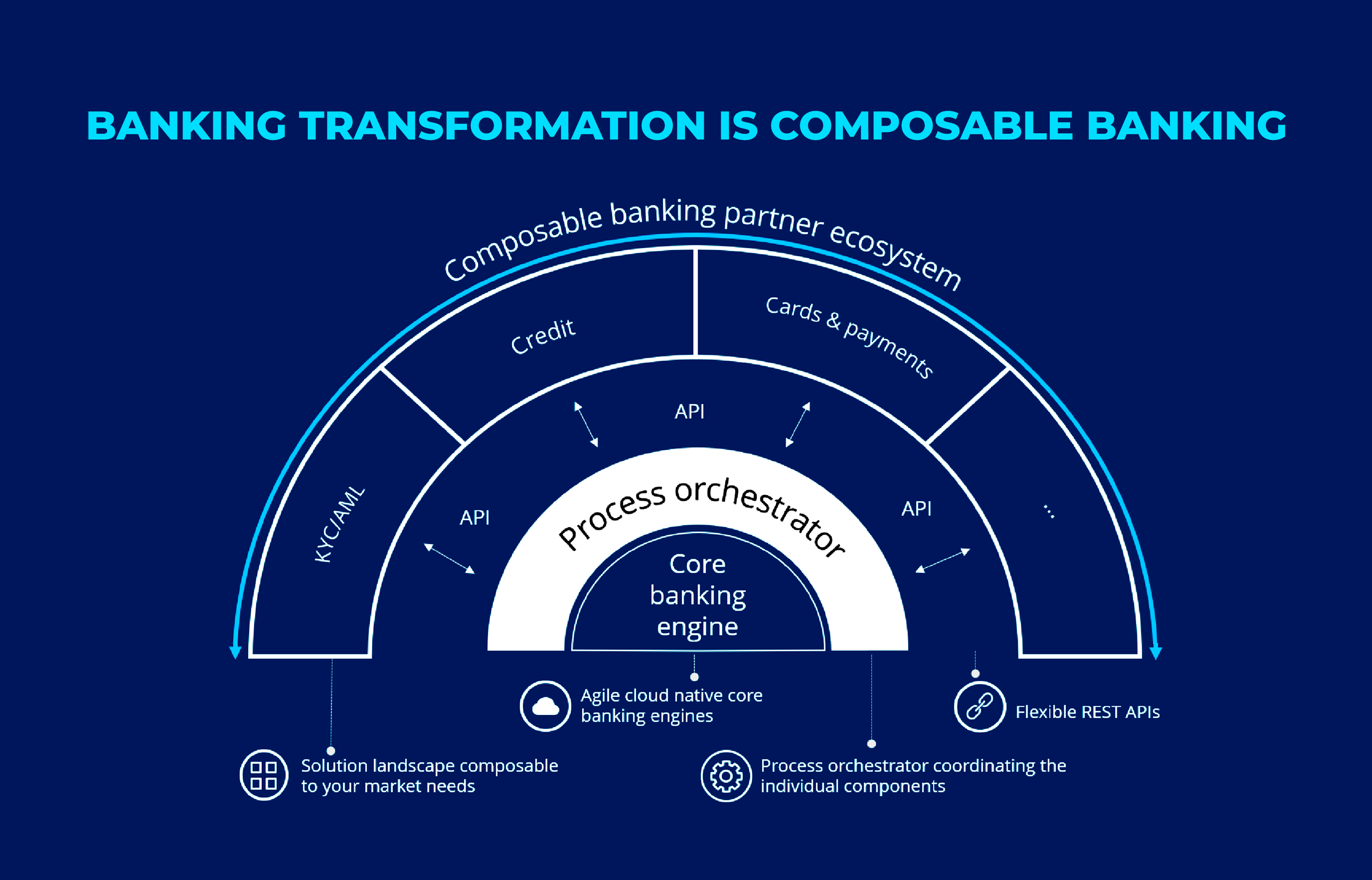This piece explores the cutting-edge concept reshaping the future of banking transformation: Composable Banking. The innovative approach is poised to revolutionize the financial industry by offering a dynamic and agile framework that distinguishes itself from traditional models and opens doors to unparalleled opportunities for banks and financial institutions.
Banking Transformation Services
Partnering with seasoned BankTech companies like Maveric that challenge the status quo through fresh thinking and deep domain contextualization is a powerful way to feed the innovation pipeline for leading BFSI players.

Defining Composable Banking
Composable Banking is a technology and transformation strategy that responds to the ever-evolving nature of the financial landscape. At its core, Composable Banking revolves around modularity and flexibility, allowing banks and financial institutions to create and orchestrate their services by assembling various independent components. This approach is based on the MACH principles: Microservices, API First, Cloud Native, and Headless. By embracing these principles, Composable Banking enables institutions to innovate swiftly, adapt to changing market conditions, and maintain a competitive edge in the industry.
Evolution Beyond Traditional Models in Corporate Banking Transformations
What sets Composable Banking apart from traditional models is its ability to transcend the limitations of monolithic architectures and rigid systems. In the past, banking transformation often entailed extensive overhauls of legacy systems, which were time-consuming, expensive, and prone to disruption. Composable Banking, on the other hand, takes a modular and interconnected approach, allowing banks to quickly swap, replace, or add components to their existing infrastructure. This flexibility empowers banks to swiftly respond to customer demands, market trends, and regulatory changes while minimizing disruption and maximizing control over their product roadmap.
Real-World Examples of Composable Banking Success
Several forward-thinking banks have already embraced Composable Banking with remarkable success. Notable among them is Monzo, a UK-based neo-bank that has harnessed the power of Microservices and API First principles to develop over 2000 microservices that power their banking experiences. Monzo’s modular architecture has enabled them to scale, secure, and manage their services rapidly, demonstrating the potential of Composable Banking to revolutionize the industry.
Citibank is another prime example of API-First implementation, utilizing the principle to expose all functionality through APIs and viewing APIs as discrete products rather than mere integrations. This approach fosters flexibility, interoperability, and reusability, key characteristics that underpin Composable Banking’s success.
Strategic Considerations while Deciding Composable Banking Transformations.
Before embarking on the journey toward Composable Banking, banking leaders must carefully consider several strategic aspects:
Modularity Assessment:
Evaluate existing systems to identify opportunities for modularization and determine the components that can be effectively decoupled and reassembled.
API Strategy:
Develop a robust API strategy that aligns with the bank’s business objectives and customer needs, ensuring seamless integration and interoperability.
Cloud-Native Adoption:
Embrace cloud-native technologies to leverage the scalability, flexibility, and cost-efficiency required for Composable Banking’s success.
Ecosystem Partnerships:
Build a network of ecosystem partners and specialist vendors to leverage the power of a multi-partner ecosystem for enhanced innovation and user experience.
Change Management:
Implement a comprehensive change management strategy to facilitate a smooth transition to Composable Banking involving employees, customers, and stakeholders.
Shaping the Future with Three Crucial Questions for Digital Corporate Banking Solutions.
As Composable Banking shapes the future of banking transformation, three crucial questions will determine its trajectory:
- How effectively can banking leaders balance modular flexibility and maintaining control over the product roadmap?
- What measures will banks take to ensure the security, compliance, and seamless integration of the diverse components in a Composable Banking architecture?
- To what extent can Composable Banking foster innovation, accelerate time-to-market for new products, and create unique customer experiences?
Conclusion
Composable Banking heralds a new era of banking transformation characterized by agility, innovation, and customer-centricity. By embracing the principles of Microservices, API First, Cloud Native, and Headless, banks can position themselves at the forefront of industry disruption. As they navigate the strategic considerations and address pivotal questions, banking leaders can redefine their institutions and shape the future of finance.
About Maveric
Starting in 2000, Maveric Systems is a niche, domain-led Banking Tech specialist partnering with global banks to solve business challenges through emerging technology. 3000+ tech experts use proven frameworks to empower our customers to navigate a rapidly changing environment, enabling sharper definitions of their goals and measures to achieve them.
Across retail, corporate & wealth management, Maveric accelerates digital transformation through native banking domain expertise, a customer-intimacy-led delivery model, and a vibrant leadership supported by a culture of ownership.
With centers of excellence for Data, Digital, Core Banking, and Quality Engineering, Maveric teams work in 15 countries with regional delivery capabilities in Bangalore, Chennai, Dubai, London, Poland, Riyadh, and Singapore.











